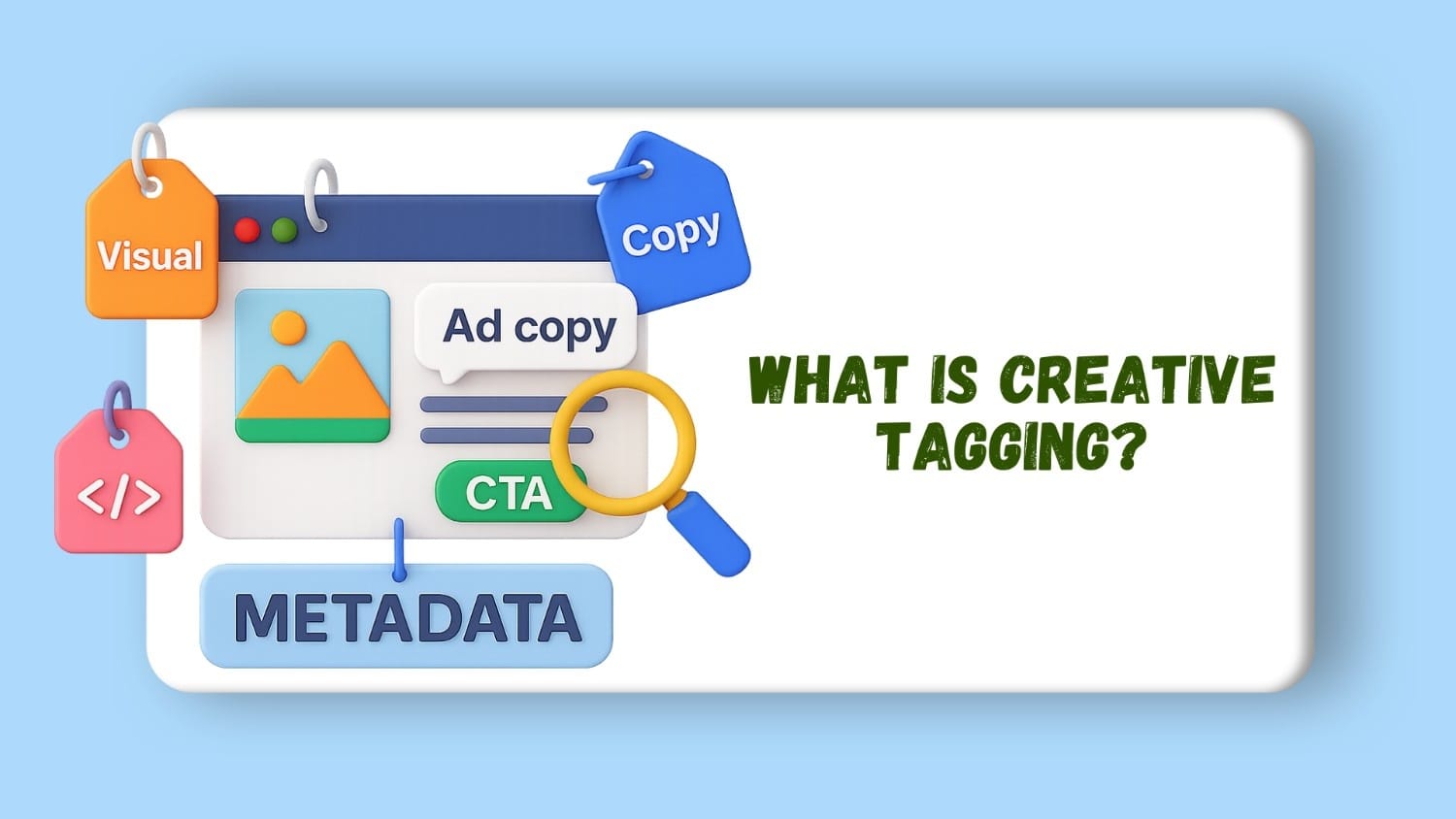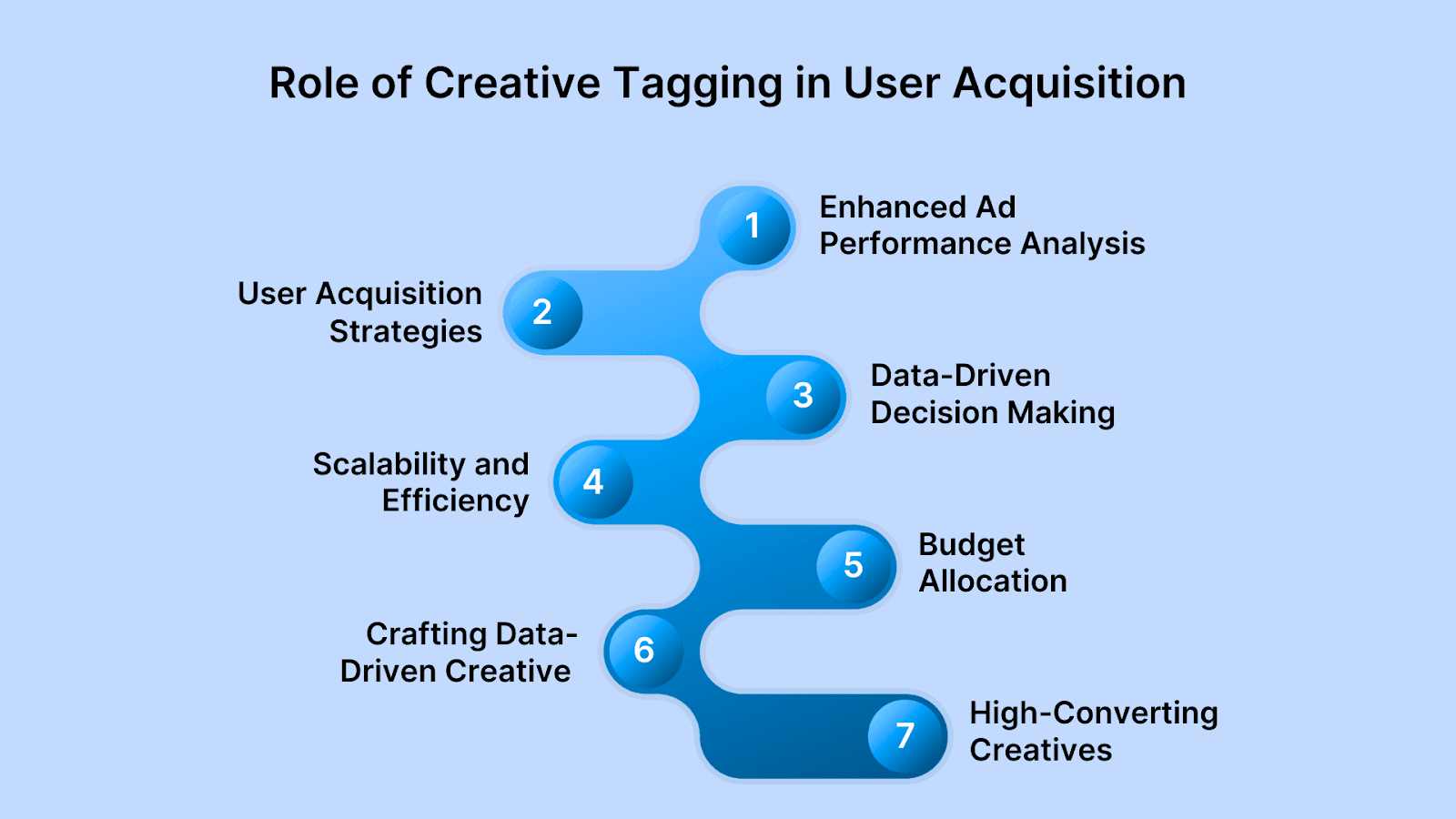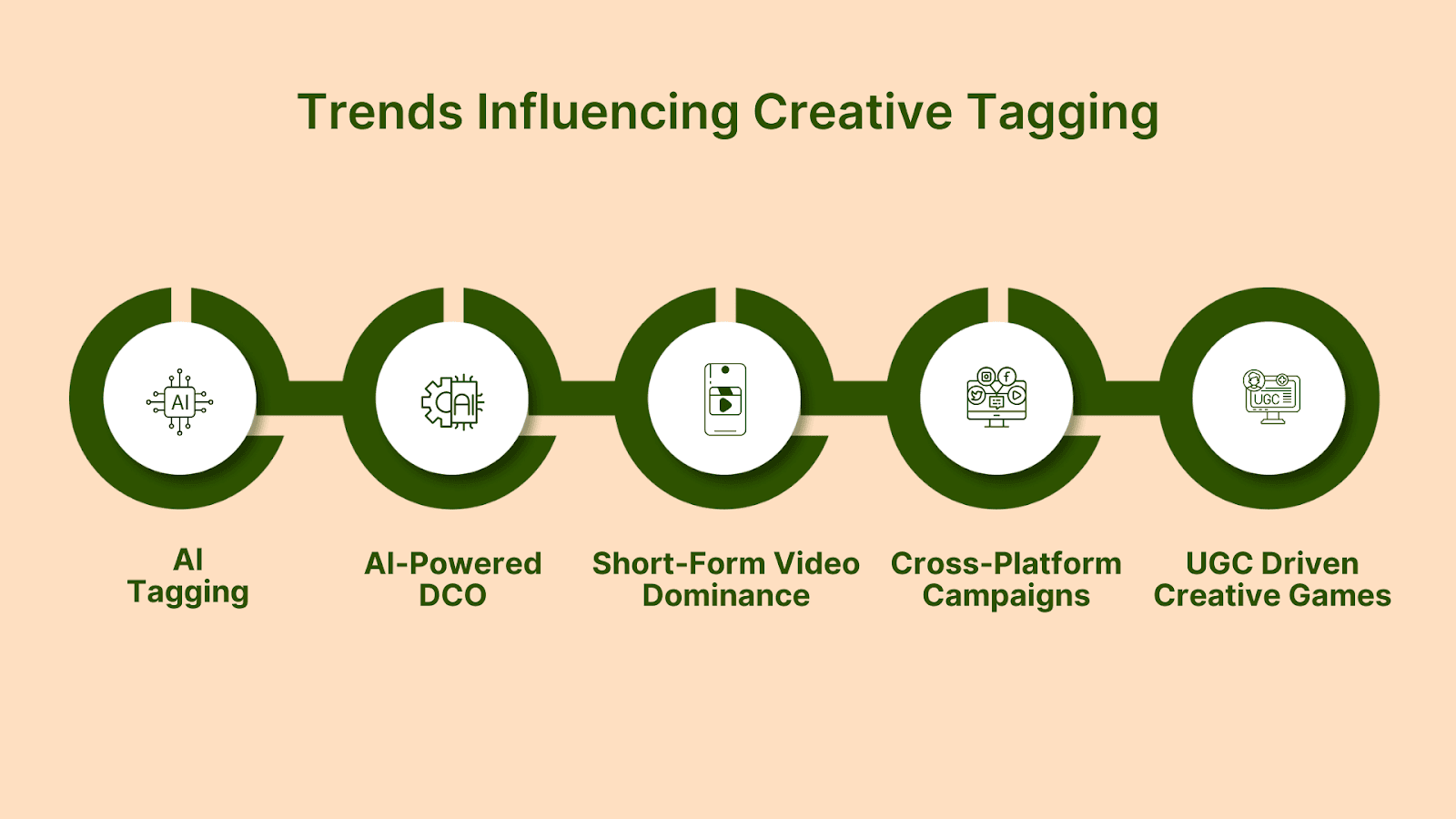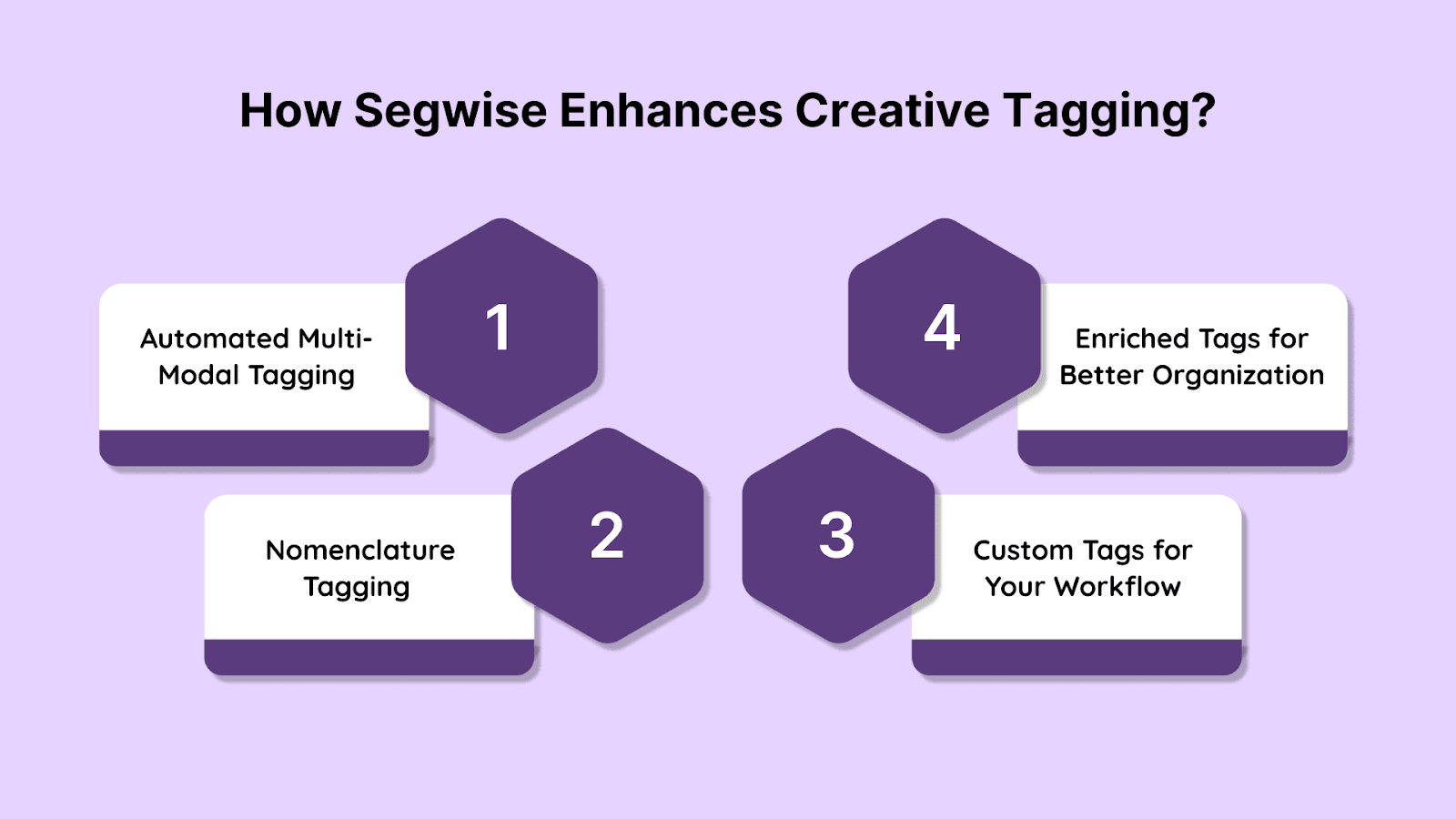Why Creative Tagging Matters for Mobile Game Marketers in 2025
In January 2025 alone, mobile games saw over 4.41 billion downloads, underscoring the massive scale of the industry. As the market grows, monthly new creatives account for about 49% of the total ads on both iOS and Android, reflecting a balanced effort to keep content fresh across platforms. With millions of games competing for attention, developers face the challenge of standing out from the crowd.
To succeed, it's not enough to simply create an engaging game; delivering the right message to the right audience through effective advertising is crucial. Now, user acquisition (UA) strategies must be precise and data-driven to make a meaningful impact. Creative tagging plays a vital role in this process, allowing marketers to break down and analyze the performance of each element in their ads.
If your UA costs are rising or creative performance is plateauing, refining your tagging and analytics workflows is now a baseline for advanced growth teams. This post will show you actionable methods for integrating creative tagging into your UA stack, making reporting, optimization, and scaling more data-driven.
What is Creative Tagging?

Creative tagging is the systematic process of labeling granular elements of ad creatives, such as visuals, copy, interactive components, and calls to action, using structured metadata. This enables quantitative performance analysis at the component level, allowing you to isolate and optimize the drivers of engagement, installs, and revenue.
The primary goal of creative tagging is to gain insights into the effectiveness of various creative elements. By systematically tagging and analyzing these components, you can make informed, data-driven decisions to optimize your ad creatives. This approach allows you to refine your messaging, visuals, and calls to action to better align with user preferences, ultimately enhancing your user acquisition (UA) efforts.
To fully understand the impact of creative tagging, it's essential to explore how it directly contributes to user acquisition.
Also Read: Understanding Creatives in Advertising: Importance and Examples
The Role of Creative Tagging in User Acquisition
Creative tagging plays a crucial role in user acquisition by allowing you to pinpoint which elements of your ads resonate with potential players. By tracking and analyzing tags, you can refine your ad creatives for better performance. This data-driven approach ensures that your campaigns attract the right audience and drive more installs efficiently.
Here are the key ways creative tagging enhances your user acquisition strategy:

1. Enhanced Ad Performance Analysis
Creative tagging allows you to analyze individual components of your ads. By understanding which elements resonate most with your audience, you can refine your creatives to boost engagement and conversion rates.
For example, by tagging your creative variants, you may find that one “challenging” hook scene boosts install rates by 30% over standard buttons, or that a specific character increases click-through by 25%. These actionable insights inform rapid creative rotation and budget reallocation.
2. Optimized User Acquisition Strategies
By identifying your top‑performing creative elements, whether visuals or messaging, you can design new ads that mirror proven winners. Suppose your tagging indicates that bright-colored backgrounds with friendly characters yield a 20% increase in conversions.
You would then prioritize that style across new campaigns or ad groups, improving your overall conversion rate. Over time, this focus on data‑backed creative choices slashes your cost per install and ensures every dollar reaches the most promising prospects.
3. Data-Driven Decision Making
With creative tagging, you gain insights into the effectiveness of different creative elements. Every time you swap out a tagged element, you instantly see which variation wins. This data-driven approach facilitates informed decisions on creative iterations and A/B testing, leading to more effective campaigns.
Rather than guessing which color, text, or animation works best, you let the performance data guide your creative iterations.
4. Scalability and Efficiency
Automated creative tagging revolutionizes the analysis of large volumes of ad creatives by systematically identifying and tagging key elements such as visuals, headline, and calls-to-action.
This data-driven approach eliminates guesswork, allowing marketers to focus on the most effective components for engagement. By testing and iterating based on performance data, campaigns can scale efficiently while ensuring higher impact and cost-effective user acquisition.
5. Budget Allocation
Not all ads are created equal, and tagging helps you identify the high performers. When you find that campaigns with strategically tagged elements lead to 40% more installs, you can shift your budget to those ads that generate the most impact.
Conversely, you can pause ads packed with underperforming elements. This dynamic budget shifting ensures your spend always supports the creatives most likely to win, reducing wasted ad dollars and improving overall ROI.
Additionally, by monitoring key performance indicators, you can detect signs of creative fatigue. If certain tagged elements consistently underperform, consider replacing those elements or discontinuing ads featuring them to maintain campaign effectiveness.
6. Crafting Data-Driven Creative Briefs
Creative tagging offers valuable insights into which ad elements resonate most with your target audience. This information helps in crafting precise creative briefs, ensuring your ads are tailored for better engagement and higher conversion rates. With the tagging data in hand, you can specify which backgrounds, characters, and calls to action resonate most effectively with your audience.
For instance, if tagging shows “Night Mode” scenes drive longer watch times, you’d include that directive in your brief. This level of detail aligns your creative team around proven ideas, cutting revision cycles and delivering ads that connect immediately with target players.
7. Developing High-Converting Creatives
Ultimately, tagging transforms ad development. You move beyond intuition and make every new asset an experiment informed by solid performance data. By continuously tagging and analyzing, you refine your ad suite into a library of high‑conversion templates, each one tested, vetted, and ready to drive installs. This translates directly into more first‑time players, higher engagement rates, and stronger growth for your game in 2025 and beyond.
By incorporating creative tagging into your user acquisition strategy, you ensure that data backs every decision. You’ll spend less time guessing and more time scaling campaigns that drive real installs, fueling sustainable growth for your mobile game.
As mobile gaming continues to evolve, creative tagging is becoming increasingly vital for optimizing user acquisition strategies. Let's examine the key trends that will shape its role in 2025.
Also Read: Effective User Acquisition Strategies and Tips
Trends Influencing Creative Tagging in 2025
Creative tagging is becoming more essential in mobile gaming. Advances in AI, cross-platform campaigns, and user-generated content are reshaping how marketers optimize their ad creatives. These trends enable more precise targeting, higher engagement, and ultimately better user acquisition outcomes.
Here are some of the key trends shaping the future of creative tagging in the mobile gaming industry:

1. AI Tagging
AI-driven tools can automatically identify and label elements in your ad assets, including visuals and music cues. Instead of manually tagging each thumbnail or headline, you let machine learning algorithms do it for you in seconds.
Segwise’s AI creative tagging, for example, automatically identifies and tags creative elements like hook dialogues, characters, colors, and audio components across images, videos, text, and playable ads to reveal their impact on performance metrics like IPM, CTR, and ROAS.
By automating tagging, you free up your team to focus on strategy and storytelling. You also get deeper insights into which assets drive installs, so you can rapidly reallocate budget to the best‑performing creatives.
How it enhances user acquisition
Speeds up insight gathering, allowing you to optimize campaigns.
Reveals top‑performing creative traits, letting you scale winners quickly.
Reduces wasted spend on low‑impact assets by tagging underperformers.
2. AI-Powered Dynamic Creative Optimization (DCO)
Dynamic Creative Optimization tools assemble ad variations on the fly based on user data and performance signals. By tagging each asset, image, title, and CTA, you provide the system with the building blocks to create the best combinations for each user.
UA teams using DCO setup see a 58% lift in return on ad spend, as every impression displays the most relevant version of your game ad. This tagging approach helps you test more ideas faster, find winning ad combos in hours instead of weeks, and scale campaigns without creating every variant by hand. The result: more installs at a lower cost.
How it enhances user acquisition
Delivers personalized ads that match each user’s interests and behavior.
Improves click‑through and install rates by showing the right creative at the right time.
Cuts manual workload, so you can run more A/B tests and find winning combos faster.
3. Short-Form Video Dominance
Short videos on platforms like TikTok, Instagram Reels, and Snapchat dominate mobile attention spans. To learn what drives installs, you need to tag elements, like the opening hook or a sound effect, in every video. For example, tagging the hook that appears at the 2-second mark lets you see if that moment prompts viewers to swipe and install.
In 2025, 85% of marketers believe that short-form videos deliver the best engagement, with up to 2.5 times more interactions than longer formats. By tagging every creative element, you’ll know exactly which moment or visual cue gets users to tap “Download,” boosting your conversion rates.
How it enhances user acquisition
Captures attention quickly in feeds, driving more ad views.
Sparks organic sharing, amplifying reach without extra spend.
Connects with younger audiences who prefer bite‑sized content.
4. Cross-Platform Campaigns
You’re running ads across app stores, social apps, streaming channels, and CTV, but how do you compare performance fairly? Ensure your creative tagging taxonomy includes device, channel, and format. With unified tags, you can analyze install or retention KPIs by channel, informing granular budget shifts as well as creative revisions targeted to each ecosystem (e.g., vertical video for TikTok vs. static assets for UA networks).
Consistent tagging across channels also helps you spot trends; for example, your game trailer may drive more iOS installs, while a static banner performs better on Android. With that insight, you can adjust your budget to lower your average cost per installation.
How it enhances user acquisition
Provides a comprehensive view of the user's journey across devices.
Helps you allocate budget to the most effective platforms.
Prevents costly over‑ or under‑investment by accurately tracking where installs originate.
5. UGC Driven Creative Tagging Mobile Games
User‑generated clips, gameplays, challenges, or player reactions now outperform branded ads in mobile gaming. A recent report found that UGC ads often feel more genuine, driving higher engagement. On TikTok, UGC videos outperform brand content by over 22% in engagement, making them a powerful source of installs.
Tag each UGC creative by format (for example, “let’s‑play clip,” “challenge format,” or “reaction montage”) and feature to pinpoint which creator styles and game moments convert best.
How it enhances user acquisition
Real players' videos feel more trustworthy than polished ads.
Tags reveal top‑performing creator formats so that you can guide influencers toward winning angles.
Drives organic shares and algorithm boosts without extra spend.
As creative tagging becomes increasingly important in mobile game marketing, utilizing the right AI-powered platforms can make all the difference.
How Segwise Enhances Creative Tagging
Segwise's Creative Tagging platform empowers you to optimize your user acquisition (UA) strategies by automating and refining your creative analysis processes. With features tailored for mobile game marketers, Segwise enables you to make data-driven decisions that enhance ad performance and drive player installs.
Key Features

Automated Multi-Modal Tagging:Segwise's AI-driven system automatically tags various creative elements across images, videos, and playable ads. This includes identifying components like backgrounds, characters, dialogues, and calls to action. By automating this process, the platform saves valuable time and resources, allowing marketers to focus on strategic decision-making.
Nomenclature Tagging: Segwise enhances creative organization by extracting tags from existing naming conventions and standardized file names. The platform learns these naming systems and automatically applies relevant tags, ensuring consistency and improving the efficiency of creative asset management.
Custom Tags for Your Workflow: Beyond the standard 20+ creative tags, Segwise allows marketers to create custom tags tailored to specific elements unique to their creative performance. This flexibility enables a more granular analysis of creative components, facilitating targeted optimizations that align with campaign objectives.
Enriched Tags for Better Organization: Segwise allows you to group related tag values into meaningful categories, providing a clearer structure for your creative assets. By organizing these tags effectively, you can easily identify high-performing creative elements. This streamlined approach enhances your creative analytics, helping you make data-driven decisions.
By utilizing these features, the AI-powered platform enables you to streamline your creative analysis process, identify winning patterns, and optimize your user acquisition efforts.
Also Read: Creative Analytics Explained: How To Track, Measure, And Improve Ad Performance
Conclusion
In 2025, creative tagging is crucial for optimizing user acquisition in mobile gaming. By analyzing ad elements, you can identify what resonates most with your target audience. This data-driven approach improves ad performance, boosts conversion rates, and reduces acquisition costs.
So, are you ready to boost your user acquisition? Try Segwise with a 14-day free trial and experience the power of AI-driven creative tagging today!
FAQs
1. Can creative tagging help reduce creative fatigue?
Yes, by tagging creative elements (tone, mechanic, persona), you can systematically rotate and remix content before creative fatigue sets in. You can automate replacements with best‑performing combinations, minimizing manual redesigns and maintaining freshness.
2. What role does tagging play in privacy‑first environments?
With privacy frameworks like the ATT and Google Privacy Sandbox, as well as regional data laws limiting user-level tracking, creative tagging enables contextual optimization. By feeding aggregated creative tag performance data to AI models, marketers can segment and target users based on content themes rather than user IDs, thereby future-proofing UA workflows.
3. How does tagging enable more effective ad formats experimentation?
Tagging helps marketers map performance across various formats, including mini-game playable ads, UGC-style videos, rewarded spots, and static banners. By tracking which formats, themes, and mechanics perform best in each region or channel, teams can optimize format mix for engagement and efficiency.
Comments
Your comment has been submitted successfully!